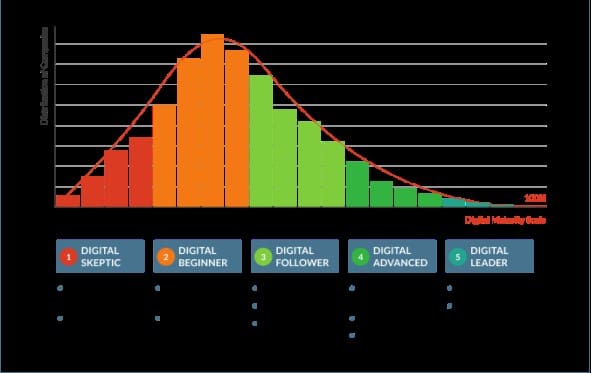Disruptive innovation has a clear impact on the half-life of companies’ business models. Protiviti’s Jim DeLoach discusses how industry disruption and digital transformation present a new frontier of opportunity and risk that is shaping – and speeding up – business model changes.
Disruptive change has been present throughout recorded history, but the contemporary notion of disruptive change really came into vogue just over 20 years ago, when former Intel CEO Andy Grove published his outstanding book, “Only the Paranoid Survive.” In it, Grove coined the term “strategic inflection point,” defining it as “a time in the life of a business when its fundamentals are about to change.” That a company can be both the subject and the cause of a strategic inflection point is a sobering market reality that cannot be taken lightly.
Now, 20 years later, Grove’s premise is especially prescient. As he so eloquently observed, “the ability to recognize that the winds have shifted and to take appropriate action before you wreck your boat is crucial to the future of an enterprise.” Today, there is greater awareness that companies that are not agile, resilient and adaptive enough to recognize market opportunities and emerging risks — and deploy the tools of the digital age to address them on a timely basis — are at risk of being swept aside by a tidal wave of disruption.
A recent global survey of board members and C-suite executives cited the inability to compete with “born digital” competitors, resistance to change and disruptive change to the business model as significant impact risks for 2020.[1] These risk issues are especially relevant as organizations strive to advance their digital maturity and embrace the transformative potential of technology. Of particular note, these issues were not at the forefront of many senior executives and board members’ minds just a few years ago.
But with the onslaught of emerging digital technologies — robotic process automation (RPA), machine learning, natural language processing (NLP), big data analytics and other components of artificial intelligence (AI) — virtually every industry is facing the challenge of transforming customer engagement, offering new products and services, facilitating more informed and higher-velocity decision-making processes and improving operational performance. Companies that are laggards or behave like ostriches with their heads buried in the sand won’t survive in this fluid environment.
Evaluate Digital Readiness
Protiviti’s research and experience indicate that few organizations are taking the steps necessary to become truly digital in nature. Across the spectrum, executives and their boards are saying they need to focus on the “digital channel” and, specifically, on the technologies and talent to drive that channel. The outcome of their efforts, however, is often a digital veneer. From the standpoint of digital advancement, the organization may appear to outsiders as if it is making progress. But beneath the veneer, true change at the organization’s core is minimal.
It is not about how much money is spent; many organizations may invest heavily in new technologies and digital initiatives, but the changes they may achieve are not transforming how the organization thinks and acts at its core. Digital transformation is about transforming the organization — its culture, people and processes — to think and act more broadly. For example, organizations should have four areas of focus centered not on specific technologies, but rather on goals and desired outcomes.
- Better customer engagement — Ask yourself: How can we get closer to our customers and end consumers?
- New business models — Ask yourself: Do we consider new operating models to strengthen our competitive position?
- Better decision-making — Ask yourself: How can we make better, more timely decisions given the huge volumes of data and information we have?
- Operational performance — Ask yourself: How can we do things more efficiently and effectively?
Our research indicates that to become digital leaders, organizations need to excel and differentiate themselves across 36 separate attributes at which we believe digital leaders excel. Using these attributes, Protiviti has created an interactive thought leadership piece — the Digital Maturity Assessment Model[2] — that has been designed not only to educate companies and their boards on what it takes to be effective in the digital age, but also to enable them to benchmark themselves against leaders and peers as they complete the assessment. Clarity on organizational strengths and areas of weakness enables the enterprise to embark on its journey to digital maturity with confidence and ensure it has the best possible chance of prospering in the digital age. We offer access to our assessment tool to the market to help organizations conduct their assessment.
Regarding digital maturity, we have identified five levels for gauging the current and desired future states of an organization in the graph below.
 It is our experience that most organizations are still at relatively low levels of maturity. When it comes to digital transformation, an organization ultimately measures success depending on where it wants to go — which may not involve being a digital leader. Positioning as a digital follower can work as long as the company is agile, has a clear strategy and is adept at change. The key is understanding where the company is now and where it wants to go. With that perspective, the organization establishes a structure and approach to measure progress toward reaching its goals.
It is our experience that most organizations are still at relatively low levels of maturity. When it comes to digital transformation, an organization ultimately measures success depending on where it wants to go — which may not involve being a digital leader. Positioning as a digital follower can work as long as the company is agile, has a clear strategy and is adept at change. The key is understanding where the company is now and where it wants to go. With that perspective, the organization establishes a structure and approach to measure progress toward reaching its goals.
The Key Takeaway
Digital leadership requires a certain state of mind. It is about changing the way an organization acts and thinks in everything it does. To be successful, executive management must prepare the organization to compete in the digital age. Management can have the best possible strategy, but the organization can’t execute it if the business is not digital-ready. It is also difficult to formulate a viable strategy if the organization is not digital-ready or does not possess the requisite digital know-how.
If the organization is a digital beginner or a skeptic, the board must encourage management to advance its digital maturity so that it is either a digital follower or a leader. Management should identify and act on strengths and weaknesses across the business in the context of the digital vision, mission and strategy. Using the above framework to benchmark itself against the 36 competencies at which digital leaders excel helps an organization better understand the pathway toward achieving digital readiness.
Understand What Transformation Entails
There have been disruptive, transformative events in business before, from the Industrial Revolution to the introduction of personal computers. Digital is just the latest. However, one could argue that today’s transformations are more pronounced than in the past.
As they consider the changes their organizations are undergoing, some executives and directors use “transforming the business” or “business optimization” over “digital transformation” to, in their view, more accurately describe their journey. For example, born-digital companies and startups don’t talk about digital transformation. They do not need to transform digitally because digital is already ingrained in their culture and operations. Thus, there really isn’t a single digital transformation that takes place, but a series of transformations — a continuum of sustained progress and milestones. Digital-native companies don’t talk about “digital transformation” as if it was a one-time event or a unique, monolithic thing. Transformation, for them, is an ongoing process.
Digital leaders roll up their sleeves to understand innovations and new technologies like machine learning, NLP, advanced data analytics and other components of AI. They do this across the organization in all aspects of the business, rather than delegate to research and development (or other functions). Executives and board members can enhance their oversight effectiveness by becoming more familiar with new technologies to improve their education and ensure their executive teams do so as well.
Digital cannot be led or governed from afar. For senior executives and directors, embracing technology outside of the work environment can be a good way of becoming “digitally literate.” For example, converting one’s home into a “smart home” and learning how to use different digital tools (e.g., using an artificial intelligence assistant (such as used in smartphones) to improve performance in the home) can facilitate an executive’s or a director’s education.
Digital familiarity and literacy are vital to probing and asking the right questions in the C-suite and boardroom regarding the company’s advancement as a digital entity, particularly when augmented by digital-savvy experience. How else can executives and board members connect with each other to govern digital initiatives and a digital strategy when they are neither digitally literate nor tech-savvy? How else can they validate the path the organization is taking?
One option may be to form an innovation committee, with engagement of technology, digital and transformation experts. Another is to include directors with the requisite technology expertise on the board to complement the directors who grew up in the analog age. Yet another option is to deepen the organization’s digital expertise and engage outside advisers to inform the executive team and board with relevant perspectives. The point is that the executive team and board must become educated and well-informed in the digital space, thus improving their ability to ask focused questions, challenge assumptions and look at the related transformation opportunities differently.
The Key Takeaway
True digitalization starts at the core. The executive team and board, therefore, must transform themselves before they can offer effective oversight of the organization’s journey to digital readiness. Just as a strategy that attempts to layer technology on an analog business does not work, neither can an executive or director who grew up in the analog age contribute effective oversight without substantive steps taken toward digital literacy and digital savviness.
Focus on Resiliency and Agility
In the digital era, good governance may need to be different than even five years ago. For example, executives and directors need to sharpen their focus on innovation initiatives and on changing the organization’s mindset concerning digital initiatives. People and culture are vital to success in digital transformation. If an organization has effective digital leadership, enhances the digital capabilities of its people and creates a corporate culture that incents and empowers creativity and innovation, it will become a truly digital organization. Changing the mindset also requires a compelling narrative regarding the company’s focus on digital transformation and the need for change. That narrative must be communicated by management effectively. Without all of these elements, change is hard, if not impossible.
How do management and the board contribute value-added oversight? That is where a technology committee — a smaller, focused board group working with management on long-term digital and innovation strategy – can be useful. It might also mean recruiting younger and technology-savvy directors to bring more knowledge of new technologies and innovation cultures into the boardroom, including a broader, more diverse perspective with respect to digital and how an organization embraces digital. The board and management should collaborate to understand the roadmap to the desired digital maturity. For example, the Digital Maturity Assessment Model discussed earlier helps organizations focus on the necessary attributes and formulate a customized plan for moving forward.
Another core role for management and the board is oversight of digital risk. How do we know that the organization’s innovation process is making progress in taking us where we need to go with respect to achieving our growth and digital transformation objectives? A dashboard report may be useful in focusing dialogue between management and the board regarding the organization’s resiliency. Such questions might include:
- Do we understand how digital is changing the economics of our business and the competitive landscape in the industry?
- Are we thinking out of the box about our business model, how we serve our customers and how the market may be different five years from now? Are our digital strategy and the way we are executing it enabling our organization to stay ahead of or keep pace with market developments?
- What fundamental assumptions have we made in formulating our strategy that could be impacted adversely by future events? Are any of our markets or operations at risk?
- How can we address any deficiencies or plan for any contingencies, and how fast can these initiatives be accomplished?
Executives and board members should disrupt themselves, their approach to oversight and how they govern. They need to encourage the organization to rethink the business and industry and assess how the digital economy is disrupting them. In addition, emphasis should be placed on picking up the pace to move faster and manage the business at the speed of change.
The Key Takeaway
Management and the board can play an important role in fostering a resilient and agile mindset. This requires digitally literate and digitally savvy executives and directors having broader, more diverse perspectives regarding how the organization should embrace digital opportunities. The dialogue should be supported with appropriate innovation-specific metrics that tell the full story of how the strategy is performing, what the return on investment is and how effective the company’s innovation culture and capabilities have become.
Watch for next month’s column from Jim, in which he will focus on three additional topics: keeping an eye on the customer experience and competitive advantage, ensuring there is a compelling plan that fits market realities and considering human(e) digital transformation.
[1] Executive Perspectives on Top Risks 2020, Protiviti and North Carolina State University’s ERM Initiative, December 2019, available at www.protiviti.com/toprisks.
[2] Go to https://landing.protiviti.com/digital to complete the digital maturity assessment to discover how your organization measures up against digital leaders and identify barriers that will prevent your business from achieving its strategic goals over time.



 Jim DeLoach, a founding
Jim DeLoach, a founding 









